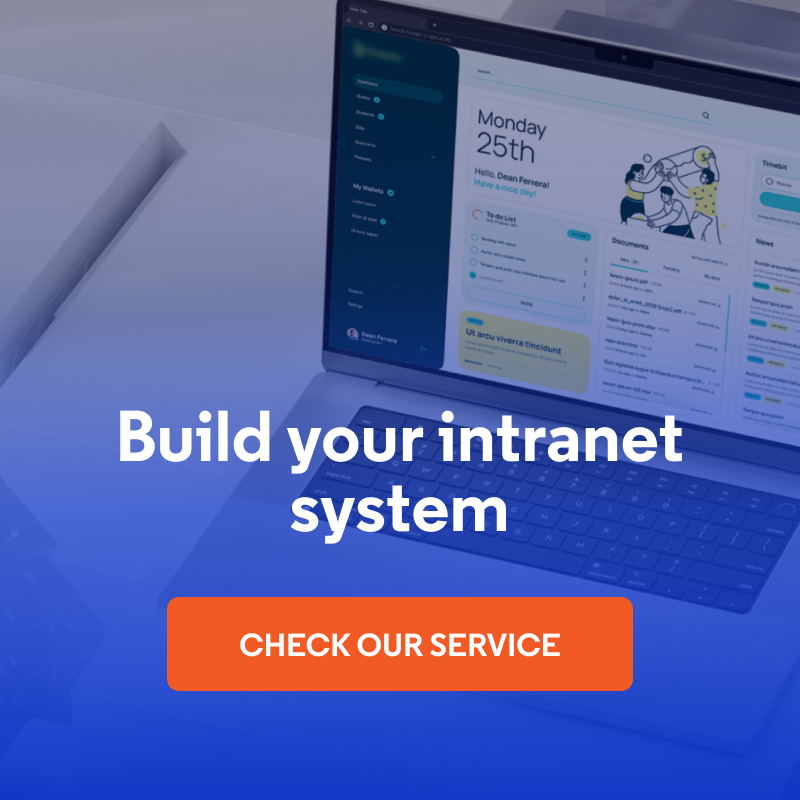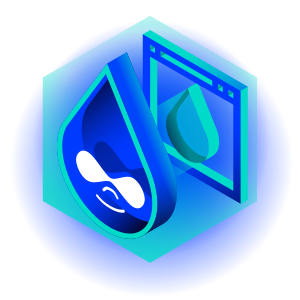
Is It Better to Build or Buy an Intranet? Selecting the Right Solution
Choosing a company intranet is a decision that can change the way your team works. There are SaaS systems on the market to launch tomorrow and custom solutions that require months of work. In between are open source systems that offer a compromise between speed and flexibility. How do you choose the best option for your organization?
In this article:
- Needs analysis - where to start when choosing a new intranet?
- Features
- Intranets available on the market - an overview of the possibilities
- Price and cost of implementing intranet solutions
- Time required to implement the employee intranet platform
- Control and flexibility of the solution
- Appearance and convenience of use
- Technologies
- Integrations
- Privacy and security
- Build or buy an intranet? Summary
Needs analysis - where to start when choosing a new intranet?
Before you start comparing specific systems, you need to understand exactly what your company needs. This may seem obvious, but most companies make the mistake of choosing a solution based on a list of intranet features rather than the actual needs of users.
Start by talking to employees from different departments. Ask them what information they look for most often, what internal communication problems they face, and which processes are the most time-consuming. Marketing may need quick access to branding materials, HR may need an efficient onboarding system for new hires, and project teams may need tools to collaborate on documents.
Also, determine the scale of the implementation. Are you talking about a 20-person company where everyone knows each other, or enterprise companies with thousands of employees in various locations? The size of the organization has a key impact on the choice of technology - what works for a startup may not be enough for a large company.
Don't forget about the technological needs. Check which systems the intranet has to integrate with - own CRM, HR system, accounting tools or communication platforms. The more integrations you need, the more important the flexibility of the chosen solution becomes.
Finally, evaluate your internal resources. Do you have an IT team that can manage a sophisticated system, or do you need a "plug and play" solution? This answer will greatly narrow down the list of available options and help you avoid costly mistakes in the future.
Features
Any intranet, regardless of the company size, should provide employees with access to key information and basic communication tools. Essential functionalities include:
- knowledge base and documents - a central repository for procedures, instructions, forms, and working materials in various formats (PDF, video, presentations),
- contact list - a complete address book of the organization with contact and structure information.
- FAQ - answers to frequently asked questions about company processes,
- calendar - a shared calendar of events, meetings, and important dates,
- news section - management announcements, notices, and company news,
- search system - the ability to quickly find the information you need throughout the intranet.
Communication functions - building employee engagement
In the era of remote and hybrid work, the intranet's social features are becoming crucial to maintaining organizational culture. Enhancing communication within your company using the intranet is possible thanks to such functionalities as:
- chat and private messaging - direct communication between employees,
- discussion forum - a place to exchange opinions and solve problems,
- comments and reactions - the ability to respond to publications,
- bulletin boards - space for informal employee communications and announcements.
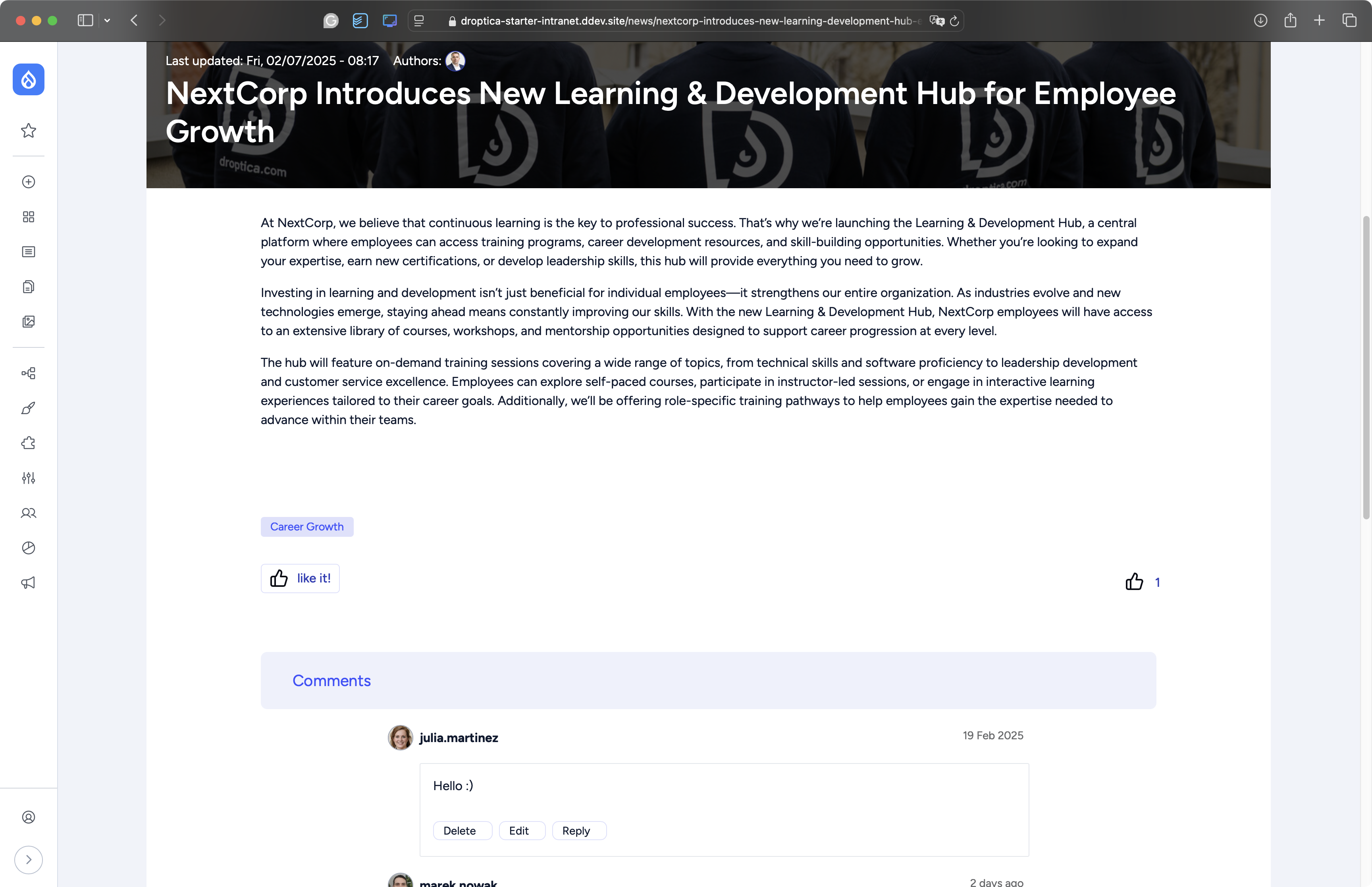
Users of the Open Intranet platform can add likes and comments to publications.
Development functions - investment in human capital
At a time when employees' skills need continuous improvement, a built-in training system can save a company thousands of euros annually on external courses. Additionally, it allows standardization of onboarding and professional development processes across the organization. Training and developing the skills of the people you hire is facilitated by:
- e-learning system - quizzes, video lessons, tests, and online courses,
- microlearning - short educational materials created along the lines of social media,
- development paths - personalized training programs for various positions,
- certificates and badges - an incentive system to confirm the skills acquired.
Management functions - process optimization
The best intranet software is not only an information platform, but also a tool for increasing a company's operational efficiency. Automating routine tasks and better managing information flow can translate into significant time and cost savings. You can find the workflow management tools useful, such as:
- time recording - tracking hours and accounting for projects,
- task management - assigning and monitoring progress toward goals,
- notifications and reminders - automatic alerts about upcoming deadlines,
- analytics dashboards - reports showing platform usage and process efficiency,
- workflow systems - automation of repetitive business processes.
The choice of specific functionalities should be based on the organization's actual needs, not on the availability of options in a particular system. It is better to have a company intranet with fewer features that are actively used by different teams than an overloaded platform used by only a handful of employees.
Intranets available on the market - an overview of the possibilities
The market for intranet solutions today offers three main paths, each with its own advantages and limitations. Choosing the right option depends on the budget, the company's technical resources, and the organization's long-term development plans.
SaaS solutions - ready-made intranets
Software as a Service systems are the most popular choice for companies needing to launch an intranet quickly. Platforms such as Microsoft SharePoint or Confluence offer ready-to-use functionality available immediately after installation, and you can start working with them almost immediately.
Main advantages:
- rapid implementation - often within days,
- no need to maintain the IT infrastructure,
- regular updates and technical support included,
- predictable monthly costs.
Limitations:
- limited personalization options,
- dependence on the supplier and its business decisions,
- costs increase with the number of users,
- less control over data and security.
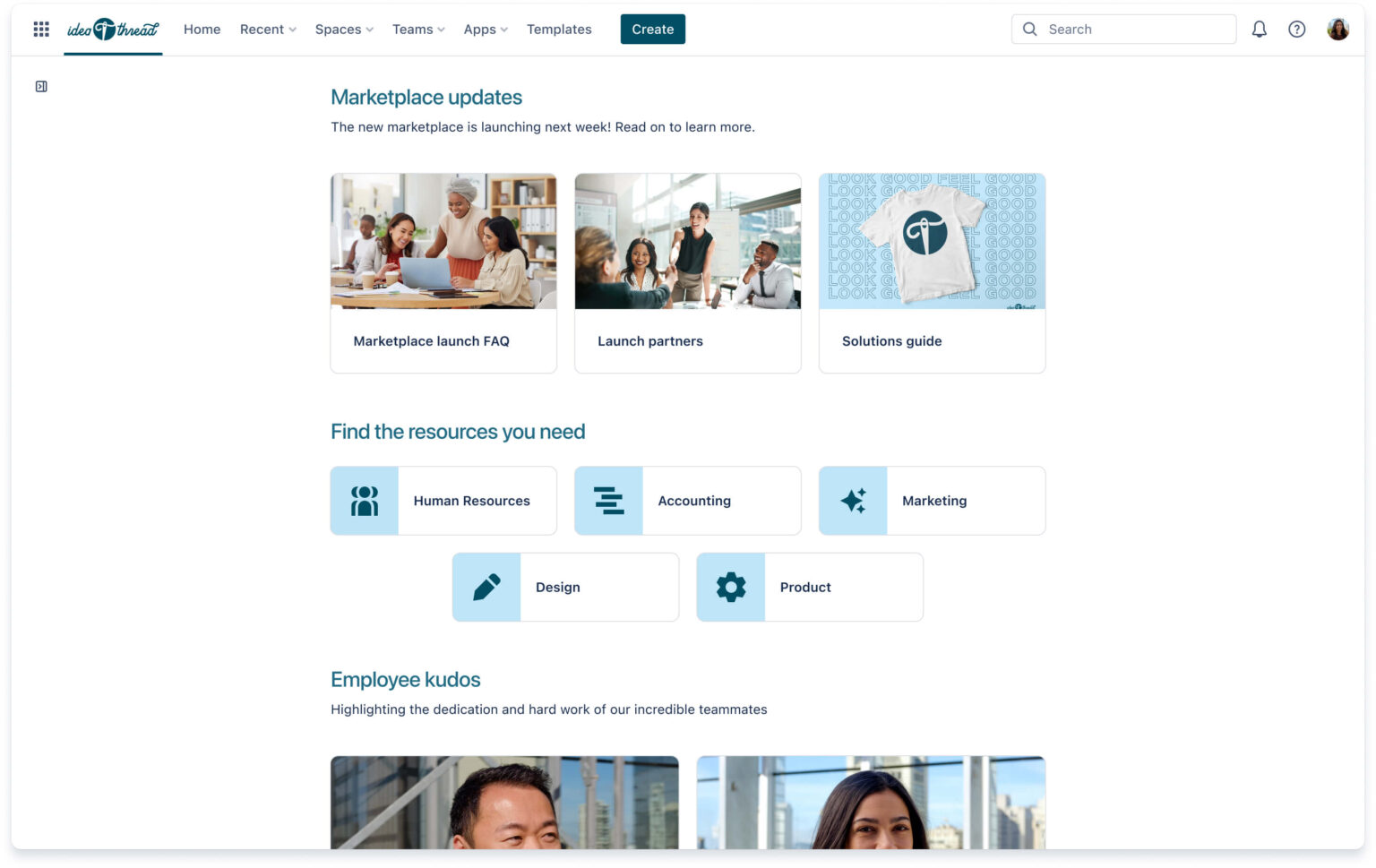
An example of an intranet created with the Confluence platform. Source: Atlassian
Custom solutions built from scratch
This is an option for organizations that need unique functionality not possible in off-the-shelf solutions. Software agencies create custom solutions to meet detailed customer requirements.
Main advantages:
- full personalization of functionality and appearance,
- excellent alignment with business processes,
- code ownership and full control of the system,
- the ability to integrate with any external systems.
Limitations:
- high initial costs,
- long implementation time (from several months to a year),
- the need to maintain a technical team,
- technical risks associated with software development.
Open source solutions
Open source systems, such as the Drupal-based Open Intranet, offer a compromise between flexibility and cost. They give access to the source code without licensing fees, but may require a technical commitment.
Main advantages:
- no licensing costs,
- the ability to modify and develop the system,
- large, active communities supporting the development of the tool,
- independence from a single supplier,
- faster implementation than custom-built systems.
Limitations:
- the need for technical competence for implementation and ongoing maintenance,
- technical support, often paid or limited,
- the need to manage security updates independently,
- may require additional modifications to fully match.
Open Intranet reduces restrictions
Open Intranet is based on Drupal and does not require the implementing company to learn about the new open source ecosystem and rules in a project of this type. In Open Intranet, upgrading, hosting, maintenance, and development look the same as in any other project built on Drupal. Knowledge on these topics is freely available on the Internet. You can use LLM-type tools (such as ChatGPT) to search for it. Just ask about Drupal, and the answer will also apply to Open Intranet. This makes it much more convenient than other open source intranet systems.
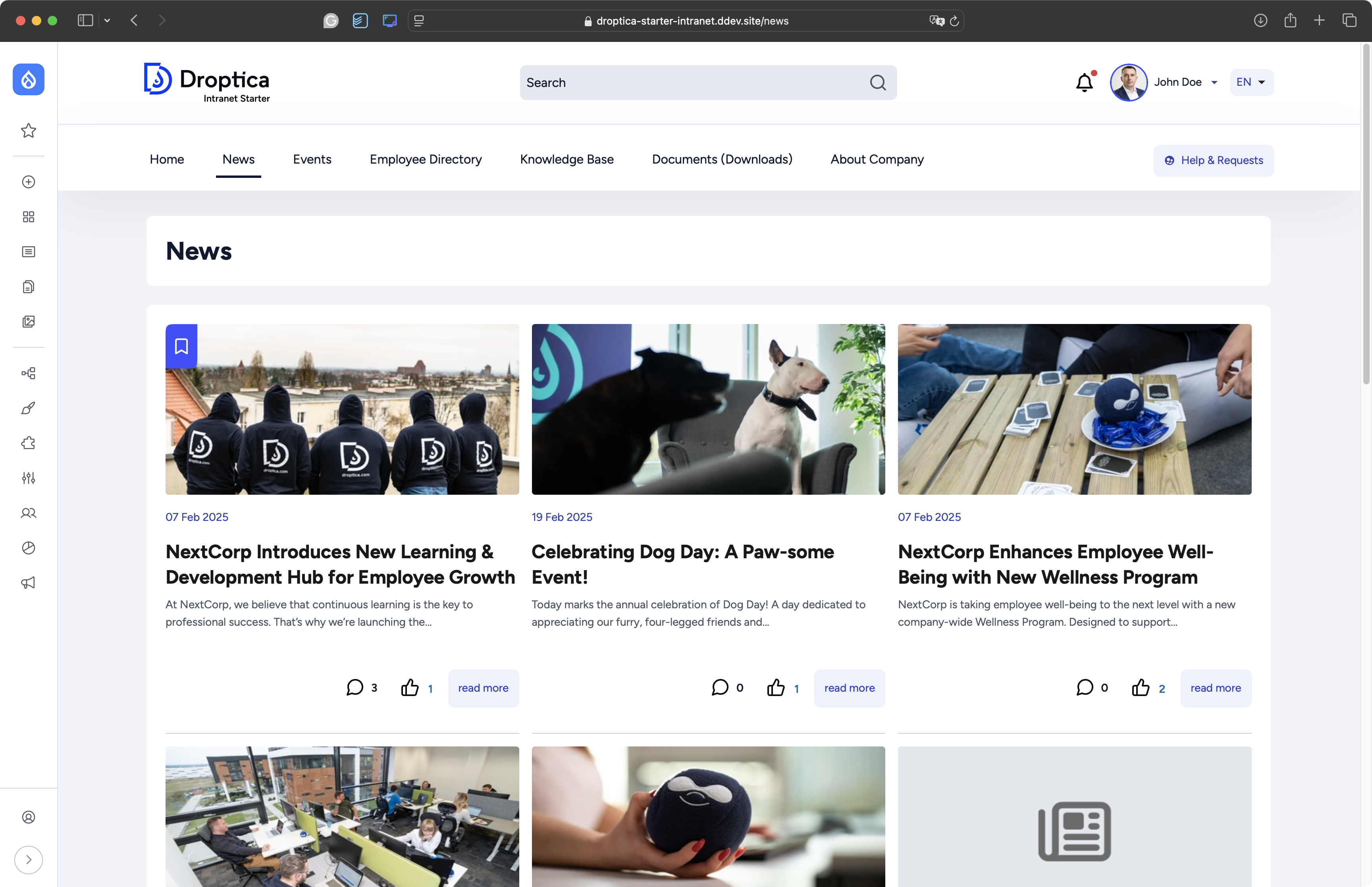
News section in the Open Intranet platform.
Price and cost of implementing intranet solutions
Cost is often a critical factor in choosing an intranet solution, but looking only at the initial price can lead to costly mistakes. It is crucial to understand the total cost of ownership (TCO) over the entire lifecycle of the system, which includes implementation, maintenance, and development of the platform.
Implementation costs - initial investment
Ready-made intranets seemingly have the lowest entry threshold - often just a several dozen euros per month for small teams. The problem arises when scaling. If your company has 500 employees, and access to the intranet for each of them costs 15 euros per month, the annual expenses already reach 45 thousand euros. For organizations with thousands of employees, subscription costs can be prohibitive.
Custom intranets require a large one-time investment - from tens of thousands to hundreds of thousands of euros, depending on the complexity of the project. This can be a barrier for smaller companies, but in the long run, it often proves more cost-effective than a subscription, especially for larger organizations.
Open source intranets offer an interesting alternative here. Open Intranet can be downloaded and installed for free. Using the open source version of the software is also free. You have to pay the cost of hosting and, optionally, training. On the side of the company deciding on an open source solution, there are also security accutualizations. If an organization needs to customize the open source version more, they can do it themselves, outsource the work to Droptica, or another Drupal company. Then the cost of customization depends on the type of changes the company wants to make to the system.
Maintenance and upgrade costs
Here, the proportions are reversed. In off-the-shelf solutions, maintenance and upgrades are on the provider's side - users don't incur additional costs, but they also don't have a say in the timing of changes or prioritization of functionality.
Personalized intranets require ongoing technical support. This means maintaining an IT team or working with outside specialists. Annual maintenance costs can amount to 10-20% of the initial investment.
Open source solutions require a similar approach to custom-built intranets, but with one important difference - you have a choice of service provider. You are not dependent on one company and can choose a local technology partner, which often translates into lower costs and better support.
Development and modification costs
In SaaS models, access to new functionality is usually a matter of moving to a higher price package. Choices are limited to a few or a dozen predetermined options, but implementation is immediate.
Custom-built intranets allow for any development, but any modification involves programming costs. Planning a budget for development becomes crucial - it is worth reserving 15-25% of the budget for functionalities that will appear after implementation.
Open source solutions combine flexibility with cost savings. Many additional modules and extensions are created by the community and available for free, for example, modules for integration with popular tools or additional communication functions. You only incur costs when you need very specialized functionality that has to be programmed by an outside company.
Hidden costs
Whatever option you choose, plan for additional expenses for user training, data migration from existing systems, and temporary productivity losses during implementation. These costs can account for 20-30% of the total investment but are often overlooked in initial calculations.
Also, keep in mind the cost of integration with existing software - the more connections you need, the higher the implementation costs can be, especially in ootb solutions with limited integration options.
Time required to implement the employee intranet platform
Implementation time is a key factor, especially when an organization urgently needs to improve internal communications or replace outdated systems. Each of the three main options offers different timelines that are worth tailoring to your capabilities and expectations.
SaaS solutions - almost instant start
If you urgently need your own intranet, pre-built solutions are the fastest way to go. You can literally get a basic version of the system up and running in a matter of hours - just create an account, add users, and start using the basic functions.
The actual implementation time gets longer when you need to customize the system to meet your needs. Configuring user permissions, importing data from existing systems, training employees, and customizing the design can take from a few days to a few weeks. In addition, integration with external tools, such as HR or CRM systems, may require technical support and additional time.
Custom intranets - patience pays off
The best custom solutions are not created overnight. Designing and building an intranet specifically for a particular company is a process that can take from a few weeks to a few months, and up to a year for very complex projects.
Implementation time depends primarily on the scope of functionality and level of personalization. A simple information portal with a knowledge base can be built in 6-8 weeks, while an advanced system with multiple integrations and personalized workflows may require 6-12 months of work.
Open source solutions - a reasonable compromise
The advantage of open source solutions is that they already have basic intranet functionality built in, so you don't have to program them from scratch. Implementation time is spent mainly on customizing the look, configuring modules, and integrating with existing company software.
In addition, the open source community often provides off-the-shelf modules and extensions that can be quickly installed instead of having them programmed. This greatly speeds up the process of implementing functionality that in dedicated systems would require weeks of programming work.
Factors affecting implementation time
Regardless of the option chosen, several factors can significantly affect the schedule:
- Data readiness - the better organized you have your documents, contacts, and other information to migrate, the faster the implementation will be. Information chaos can prolong the process by up to several weeks.
- Team involvement - projects involving representatives from different departments of the company are implemented faster and more efficiently. Lack of clear business decisions is the most common cause of delays.
- Integration complexity - connecting your intranet to multiple external systems always lengthens the process. Plan extra time for testing and tuning connections.
Remember that faster intranet implementation does not always mean a better result. Sometimes it's worth spending extra weeks carefully planning functionality and rethinking processes rather than struggling for months later with a mismatched system.
Control and flexibility of the solution
The level of control over an intranet system and its customizability are key factors that significantly affect the long-term value of the chosen solution. The various options available on the market offer completely different approaches to managing and personalizing the platform.
SaaS solutions offer limited flexibility - you can usually change logos, colors, or element layouts within the available templates. However, deeper functionality modifications often require moving to more expensive plans or are impossible at all. You are dependent on the vendor's plans and have no control over the direction of the product.
Dedicated systems give you full control over every aspect of the platform. You can define exactly the functionality you need and customize the interface to meet your organization's specific requirements. This solution is ideal for companies with unique business processes or high security requirements.
Open source solutions are a compromise between flexibility and accessibility. With open source code, you have the ability to modify the system as needed, while benefiting from the work of the developer community. An example of this approach is Open Intranet, a Drupal-based system that offers ready-made functionality with the possibility of further expansion and personalization.
Data management and hosting
The choice of solution also determines the level of control over the organization's data and technical infrastructure.
With SaaS systems, data is stored on the provider's servers, often in the cloud. While convenient, this means limited control over the location of data and dependence on the third-party provider's security policies. For companies requiring compliance with certain regulations (e.g., RODO), this can be a problem.
Dedicated solutions allow you to have full control over hosting and data management. You can choose whether the system will run on your own servers or in the cloud of your choice. This is especially important for organizations in the financial, medical, or government sectors.
Open source platforms offer the most flexibility in this regard. You can host the system on your own infrastructure, choose a cloud provider or use managed hosting services. Open Intranet can be deployed both locally and in any cloud, maintaining full control over your organization's data while using proven technology solutions.
It is worth remembering that greater control also means greater responsibility for security, upgrades, and system maintenance. Therefore, choosing the right level of control should be tailored to your organization's technical capabilities and needs.
Appearance and convenience of use
The user interface is the first element that employees encounter when logging into an intranet. Good design can determine the success of the entire project - even the most functional platform will not be used if its user experience is unintuitive.
SaaS systems offer limited customization - you can change the logo, colors and choose from available templates. However, the appearance may change without your permission when you update the system.
Dedicated solutions give you full freedom in interface design. You can create a unique design that reflects the company's identity and improves employee experience.
Open source platforms offer a compromise between flexibility and speed of deployment. An open intranet based on Drupal allows for considerable visual personalization using ready-made components. You can customize the color scheme or layout of elements.
Responsiveness of intranet software
Responsiveness is already a requirement, not an option. When working remotely, employees need to access the intranet from different devices. Unfortunately, not all SaaS solutions are fully responsive. Drupal-based systems use fluid layouts and special modules to optimize display on mobile devices. Open Intranet offers full responsiveness from the start, providing convenient access regardless of device.
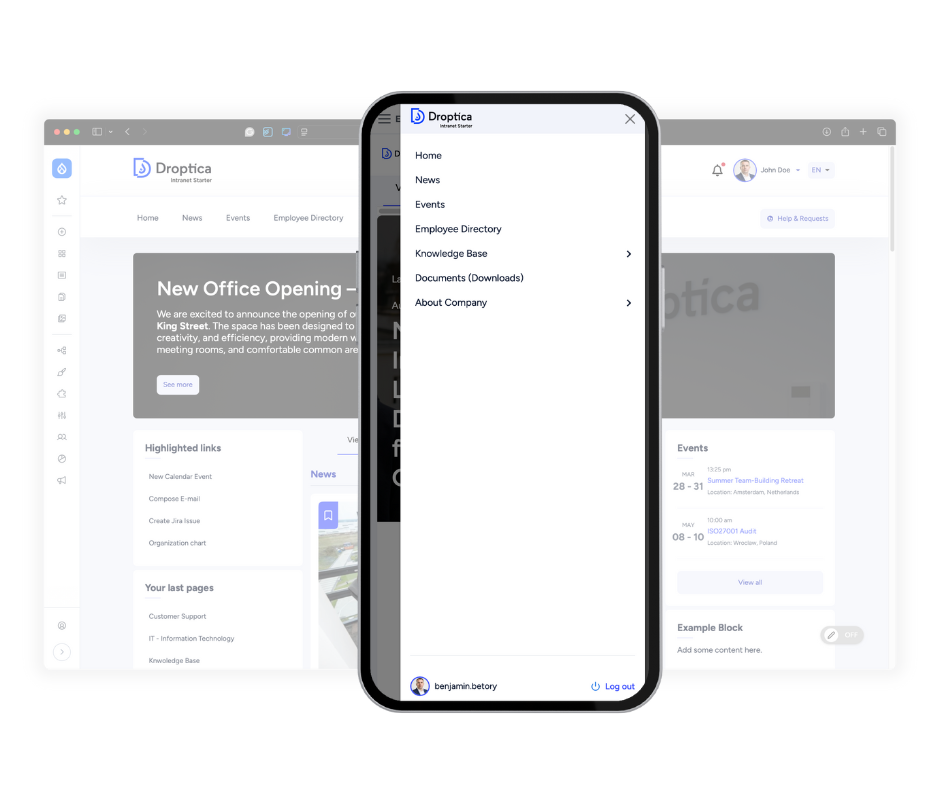
Technologies
The choice of technologies underpinning an intranet system affects its long-term effectiveness, growth opportunities, and maintenance costs. Different types of systems offer different approaches to technological issues.
SaaS solutions completely take away your influence over the choice of technologies used to develop the platform. You are dependent on the vendor's decisions and its technology plan. On the other hand, you get access to the technical support teams as part of your subscription package - the most expensive plans often include a dedicated technical supervisor.
Dedicated systems give you full control over the choice of technology, but require the right expertise in your team or cooperation with external specialists. You can align the technology stack with the solutions already in use in the company, making integration and maintenance easier.
Open source platforms offer the best combination of control and community support. Technologies such as Drupal, on which Open Intranet is based, have a large and active community of developers regularly releasing updates and new features.
Choosing an open source technology for your own intranet brings several important benefits:
- access to the system code without having to purchase expensive licenses,
- the possibility of any modification of the solution according to the needs of the organization,
- freedom to change service providers.
Open source technologies are also characterized by the high availability of specialists in the market. Choosing a popular solution such as Drupal guarantees easy access to companies and freelancers with the necessary skills and competitive price quotes.
Integrations
A modern intranet does not function in a vacuum - it must work seamlessly with the ecosystem of tools already in use in the organization. The integration capabilities of different solutions significantly affect their practical value and user adoption.
SaaS systems usually offer a predefined set of integrations with popular tools. While the list may seem impressive, you are limited to the solutions selected by the provider. If your company uses less popular or industry-specific systems, you may find that integration is impossible or requires expensive intermediate solutions.
Dedicated solutions give you full integration freedom, but each connection requires custom programming. This means higher implementation costs, but also the ability to create a perfectly tailored ecosystem of tools.
Open source platforms are a compromise - they offer extensive integration capabilities using off-the-shelf modules and plugins.
Privacy and security
Security of company data and employee information should be a top priority when choosing an intranet solution. Different types of intranets offer different levels of control over security and data privacy.
SaaS systems shift responsibility for security to the provider, which can be both an advantage and a disadvantage. On the one hand, you don't have to worry about security updates or threat monitoring. On the other hand, vendors rarely explain in detail how they fend off potential attacks by cybercriminals, which can be questionable for organizations with high security requirements.
Dedicated solutions give you full control over security implementation, but they require the right expertise and resources. You have to take care of all aspects of security yourself - from server configuration to regular updates and monitoring.
Open source platforms offer the transparency that closed solutions lack. You can see exactly how the security system works. Drupal's developers place great emphasis on security, so the technology is recommended for projects that require advanced security features. This CMS is equipped with a bug reporting system, which is able to catch any vulnerability or security breach and then inform the appropriate team about it. Regular updates to the software and installation of the latest versions of modules allow you to keep your Drupal intranet and its users well protected.
Build or buy an intranet? Summary
The decision-making process between buying or building an intranet solution should come from an in-depth analysis of the organization's needs, available resources, and long-term business goals. There is no universal solution - each approach has its place in different scenarios.
When to choose SaaS solutions?
SaaS systems are the best choice for organizations needing to quickly implement basic intranet functionality. They work well for small companies (up to 50 employees) that don't have their own IT team and prefer predictable costs every month. If your organization has standard communication needs and does not require advanced integrations, an off-the-shelf solution may be sufficient.
When to choose building an intranet from scratch?
Building a system from scratch makes sense in large organizations with complex, unique business processes. It's a solution for companies that treat the intranet as a strategic competitive tool and have a significant budget and technical team. Dedicated systems also work well for organizations with high security requirements or specific regulatory requirements.
Open source solutions as the golden mean
Open Intranet and similar open source platforms are good solutions for companies of any size. They combine the flexibility of dedicated systems with the availability of SaaS solutions. They are an ideal option for companies that want to control their data, avoid monthly user fees, and retain the ability to develop the system in the future. If you're considering an open source intranet, schedule a free consultation. We'll show and tell you more about the Open Intranet platform and how it can be customized for your team.
***
Updated article dated 19/05/2023


